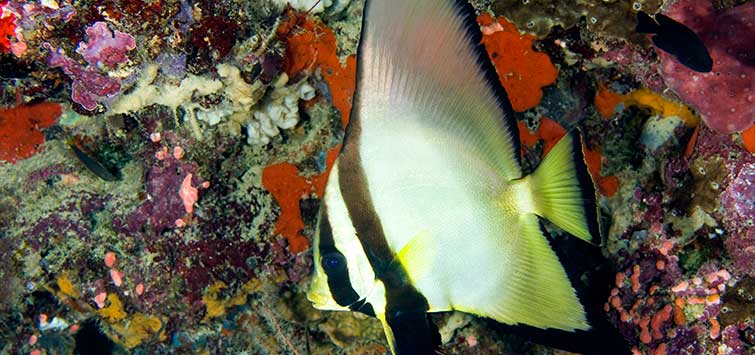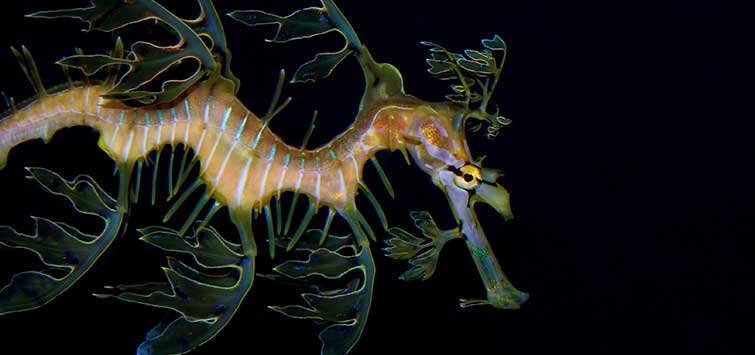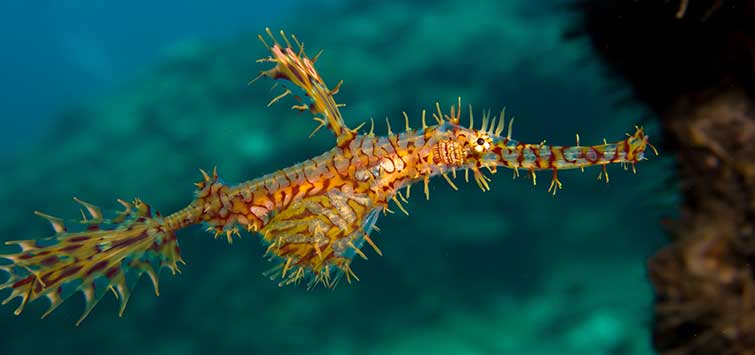Dietary Discovery May be Key to Keeping the Pinnatus Batfish
Author: Bill Rosser
Once nearly impossible to keep in aquariums, batfish may have better odds of thriving in captivity thanks to this new dietary discovery!
Over the last few years, some major advancements and discoveries have been made in the aquarium industry and the conservation of coral reefs, but it's a rare occasion when the two areas overlap and provide a leap forward that can dictate the fate of a species in the home aquarium, both as a species and as an individual specimen.
Batfish Basics
The pinnatus batfish (Platax pinnatus), also known as the dusky batfish and the red-faced batfish, is always a showpiece of any aquarium it's in. As a juvenile, it truly is a wonder to behold. Gliding effortlessly through the aquarium, it should come as no surprise that aquarists adore this fish. P. pinnatus juveniles have a round, black body with long dorsal and anal fins. The entire perimeter of the fish is outlined with a breathtaking fiery neon orange that can best be described as the color of magma. Unfortunately, and to the dismay of many, as the fish mature, they lose nearly all of the juvenile features that lead most people to purchase them.
As the fish matures, the brilliant magma-colored outline fades and eventually disappears. The fish's body grows into the long, flowing fins, resulting in an adult that is more triangular-shaped, similar to that of an adult mono (Monodactylus sebae). The dark black gives way to a dull gray to silver color. Many adults will exhibit a dark bar through the eye and through the pectoral fins and sometimes one or two bars horizontally through the body. Adult pinnatus batfish can grow in excess of 12 inches long with a fin-to-fin height of 18 inches, but in captivity, this is an average size.
However, there's one problem: It’s the showpiece for only a short period of time before it dies. Sometimes specimens live for a few months, and others may survive several weeks, but even sadder is the fact that 90 percent live only a few short hours or days.
Mortality Rate
P. pinnatus tend to have a much higher mortality rate than the other species of batfish. They ship very poorly and typically die within the first several days of being collected. It should also be briefly mentioned that tank-raised specimens are available. They're rare, but they do exist. They are extremely difficult and should be kept only by experts—this cannot be stressed enough.
Good News
But there is good news! In 2006, a group of scientists from James Cook University in Queensland, Australia conducting a conservation study at the Great Barrier Reef inadvertently made surprising observations that may shed some light on the captive needs of P. pinnatus. For the most part, this information has been slow to trickle into the aquarium industry. Hopefully, based on these observations, new standards can be set with respect to the dietary needs of P. pinnatus that will greatly reduce its mortality rate in the aquarium.
Pinnatus Batfish in the Wild
Pinnatus batfish are native to the western tropics of the Pacific Ocean. They can be found from the Ryukyu Islands to Australia. They tend to be most common in Australia where they inhabit the waters off central Western Australia, around the northern portions and south to the central coast of New South Wales.
Adult P. pinnatus typically haunt inshore and coral reef waters. Adults are generally solitary and found under rocky overhangs at the outer edges of the reefs. It is not uncommon for them to be found at a depth of at least 20 meters (65 feet).
Juveniles, on the other hand, tend to prefer much shallower water. They commonly spend much of their time cruising mangroves and inner, sheltered reefs in search of caves and ledges in which to seek shelter and food—mostly algae, but also crustaceans, various corals, anemones, jellyfish, and an assortment of zooplankton.
A Feeding Experiment
The scientists documented that P. pinnatus drastically reduced and reversed macroalgae growth on corals in the Great Barrier Reef while conducting studies simulating overfishing. To simulate overfishing, the scientists cordoned off portions of select reef with large cages to prevent any fish larger than 1.37 inches wide from accessing the reef. Without large, herbivorous fish, seaweed and algae quickly overtook the reef.
They continued this for three years, after which the cages were removed. Scientists hypothesized the usual suspects would come in and clean up the seaweeds and algae— primarily parrotfish and surgeonfish. Neither were able to do so, nor were the other 41 herbivores that are common to the Great Barrier Reef. Contrary to their hypothesis, P. pinnatus was the most efficient in the reduction and reversal of nuisance seaweed and algae.
Results
Taken slightly out of context only to summarize the study for this article, the leader of the study, David Bellwood, in effect wrote: A rich herbivore biodiversity may not offer the protection that one might assume. While the usual herbivorous suspects may help maintain the reef and prevent it from becoming overgrown by large algae in the first place, they are not able to reverse that transition. In five days, the batfish had halved the amount of weed. In eight weeks, it was completely gone and the coral was free to grow unhindered. If P. pinnatus is the last grazer of dense weedy stands on inshore coral reefs and it goes into decline, the capacity of these reefs to recover from changes could be lost forever.
Tips for Batfish Care
P. pinnatus is very susceptible to Cryptocaryon irritans and Amyloodinium ocellatum, commonly known as ich and marine velvet respectively. If a purchased specimen is found to be infected with one of these diseases, the problem must be addressed immediately. There are several measures that can and should be taken.
Freshwater Dips
First, brief freshwater dips are very effective at killing ich and should be done assuming that the batfish shows no abnormal signs of stress. If the fish already appears overly stressed, a freshwater dip could be the proverbial nail in the coffin. Please do research on the topic of freshwater dips before doing one, especially on such a delicate species as this.
Quarantine Tank
Secondly, a quarantine tank is a life saver for this species. Please note that quarantining all fish is extremely important. Quarantine tanks allow for a calm acclimation to the confines of an aquarium. They prevent bullying to newly acquired fish by established specimens. But more importantly, they prevent disease from being introduced to the main aquarium. Aquarists have opportunity for focused observation and treatment via medications or other practices.
In the case of batfish, it is important to acclimate the specimen to a quarantine tank with a salinity of 1.014 to 1.017. This low specific gravity aids in killing C. irritans so effectively that oftentimes no medication is required at all! But that works only for ich. Medicinal treatments may still be needed for other ailments. By the time their quarantine period is up and they are introduced to the main aquarium, they should be feeding well and accepting the same diet as their tankmates.
Contrary to all aspects previously mentioned in this article detailing the hardiness of this species (or lack thereof), once an otherwise healthy looking P. pinnatus has been selected, purchased, properly acclimated, treated for disease, and successfully fed, it can prove to be a hardy fish if the main aquarium suits its needs.
Keeping Batfish
Aquarium Setup
To provide the best chances for the long-term survival of this species, an aquarium of no less than 300 gallons should be considered. The dimensions of a standard 300-gallon aquarium provide the length, width, and height that P. pinnatus requires. Anything less will dramatically constrain the fish's movements, which will result in stress and possibly abrasions from rocks and glass, both of which can lead to disease and death.
P. pinnatus are not recommended for reef aquariums. They will eat an assortment of crustaceans as well as nip and nibble away at many corals and anemones. Hence, they are more suitable for a FOLWR (fish-only-with-live-rock) aquarium.
The ideal aquarium should provide ample open swimming space as well as visual barriers, caves, and overhangs, but not so many that the ability to swim freely is impeded. Batfish are large and are active throughout the day. If they feel threatened for any reason, they will be grateful for a dark place to seek refuge. Regardless of how the rockwork is laid out, the primary goal is to provide shelter, security, and swimming space for the fish while allowing easy maintenance of algae and access to equipment that may be within the tank.
Filtration Basics
For an aquarium this size, using a sump design with wet/dry filtration is fins-down the best option. Sumps are capable of moving water through the filter media at rapid rates, ensuring that the aquarium's water is turned over several times per hour. By incorporating wet/dry, or trickle, filtration into the sump, the efficiency of breaking down nitrites is greatly increased. As an added benefit, the total amount of dissolved oxygen in the water is increased, which is vital to the well being of all the aquarium's inhabitants.
Chemical filtration is also very important. This is easily accomplished by placing a bag of aquarium carbon in an area of high water flow within the sump. Carbon will aid in removing impurities from the water such as fats, acids, proteins, and dissolved wastes. By removing these organic byproducts, the water will look polished and crystal clear.
Skimming and Sterilization
It is strongly recommended that the aquarium be equipped with a quality protein skimmer. The protein skimmer, like the previously mentioned filters, also aids in removing unwanted compounds from the water. Ideally, you want to adjust the skimmer to collect a liquid that resembles green tea. By doing so, toxic compounds and phosphates will be removed more rapidly than if it were collecting a dry foam.
Many consider a good protein skimmer to be a must to maintaining a healthy aquarium. In addition, some people like to run UV sterilizers.
As previously mentioned, P. pinnatus are prone to outbreaks of ich and, to a lesser degree, other external parasites and infections. Because of this, it may be wise to place a UV sterilizer in line with the return of the sump. This will ensure that all water returning to the aquarium will have passed through the UV sterilizer, thus killing any types of parasites that flow through the unit.
Water Quality
Maintaining proper water quality is extremely important for the long-term survival of any aquarium. For all intents and purposes, a saltwater aquarium, be it a FOWLR aquarium or reef aquarium, can be kept almost the same in regard to the water. Some minor adjustments can be made to the salinity, alkalinity, and calcium depending on what type of aquarium is being maintained.
With that stated, the aquarium should be well-filtered and circulated, and the water parameters must be monitored on a regular basis. Water quality should be maintained in optimal conditions to keep the fish long-term. As recommended for every marine fish, water parameters should fall within a particular range. The specific gravity can be kept within the wide range of 1.018 to 1.025, depending on whether the aquarium is fish-only or reef. The pH should be kept at 8.2 to 8.4. Alkalinity should be between 3.5 to 4.5 meq/L (or 10 to 12 dKH). Ammonia and nitrites should be zero or as close to that as possible, as these can be very toxic even in low concentrations. Nitrates should remain as close to zero as possible but are acceptable up to 10 ppm. The aquarium temperature should be 77° to 80°F. It is important that this temperature does not fluctuate rapidly, as this will cause the fish undue stress.
Tankmates
P. pinnatus are very peaceful, easy-going fish. While they will squabble with their own, they do very well with other peaceful species. Some good tankmates include, but are not limited to, all species of tangs and aquarium-suitable butterflyfish. With care, most angels are acceptable, too. All species of dwarf angel will coexist nicely with batfish. Gobies, blennies, cardinalfish, most reef-safe wrasses, and clownfish are excellent candidates too. Assuming the batfish is too large to consume whole, lionfish and the vast majority of eels will leave batfish alone as well.
P. pinnatus must be introduced to the aquarium as the dominant fish. Meaning, in regard to some of the larger suitable fish previously mentioned, the batfish should be the first fish in the aquarium and all new fish should be smaller upon their introduction to the aquarium. Since young and juvenile batfish have fins that make irresistible targets for fin nippers like damsels, puffers, and triggers, these fish should be avoided as tankmates.
Feeding
All species of Platax are omnivorous, meaning they consume both animal proteins and plant matter. This diet should be replicated as accurately as possible in captivity. The acclimation/quarantine period is key to establishing the new fish's diet. Initially, it may be necessary to offer live food. If this is the case, depending on the size of the batfish, either live brine, mysid, or ghost shrimp should do the job.
Regardless of which one is offered, they should all be gut-loaded and enriched with a vitamin supplement. As they adapt to feeding in the aquarium, prepared foods can gradually be offered to them.
Being omnivorous, it is important to vary their diet. Pinnatus batfish absolutely relish shrimp, krill, crab, squid, bloodworms, and live and frozen brine and mysid shrimp, but their recently discovered need for algae cannot be neglected.
It had long been believed that P. pinnatus batfish are largely carnivorous, primarily consuming crustaceans, corals, anemones, and various zooplankton while consuming minimal amounts of algae matter. It was not known how much plant matter they actually do eat until the scientists at James Cook University made their surprising observations during their study.
Likewise, for many years, most aquarists likely fed a diet that was heavily carnivorous and offered minimal amounts of seaweeds and algae. In turn, many P. pinnatus probably perished due to malnutrition. Therefore, any attempts to maintain this species in captivity should factor in this new information.
While the exact species of algae were never described in the study entirely, they are described to be mainly macroalgae. In the home aquarium, this can be provided in the way of dried, prepared kelps/seaweeds and live, fresh Chaetomorpha, Caulerpa racemosa, C. prolifera, and C. Mexicana, as these are commonly grown in many refugiums.
If fresh or dried seaweeds are not available, first and foremost, Platax pinnatus should not be purchased. However, in the event that the supply of food becomes unavailable after the fact, green leafy vegetables can be used as a temporary substitute. Perhaps the best leafy greens to offer would be romaine and arugula lettuces, as they are very nutrient dense. They can be secured to a rock with a rubber-band or to a clip/suction cup. Keep in mind that these should be used temporarily and should not replace the natural diet of seaweed.
With all this being stated, the diet of P. pinnatus should be a ratio of one part animal protein to two parts vegetable matter. All fish do better if offered small amounts of food throughout the day as opposed to one meal a day. Three to four offerings of food a day will generally suffice. All food items should be appropriately sized and, once again, vitamin-enriched.
Captive Breeding?
P. pinnatus batfish are not likely suitable for breeding in the average home aquarium due to their size and the pelagic needs of their larvae. But there is more good news! Courtesy of mankind's huge appetite for seafood, this species is being aquacultured on fish farms in Indonesia for the local fish markets. Small numbers of these aquacultured batfish are being imported into the US solely for the aquarium industry. Hopefully, with captive-bred specimens available, combined with new information regarding the batfish’s natural dietary habits, this wonderful species will earn a well-deserved spot in the aquarium industry and the aquariums of dedicated hobbyists.
Closing Thoughts
Keeping beautiful, healthy specimens in the home aquarium is the goal of every hobbyist. As advances are made in technology and husbandry, more and more people are entering the marine aquarium hobby each day. It should be no surprise that upon seeing a juvenile P. pinnatus for the first time, one will be captivated and awestruck byits striking contrast of colors and the gracefulness with thich it glides effortlessly through the water. Combine its bold presence, mellow nature, and rarity in the home aquarium, and one can understand why this species can make a show-quality resident in a suitable aquarium.

.png?h=595&iar=0&w=2781&hash=5FD5E69473BCC22199FBFA2FB71B6033)



